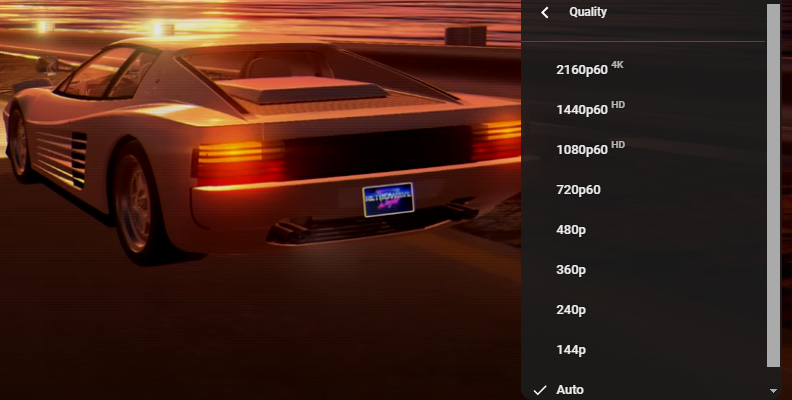In video production, different resolutions are used by people who create, edit, or watch video content. Two main categories that are often debated are SD and HD, and it's common for content creators to wonder which one is better and which resolution to use for their videos, such as 480p, 720p, 4k, etc.
In today's article, I'll explain SD and HD resolutions and their main differences. I'll review each resolution individually, including the types of formats, pros, and cons, to give a clear insight into SD vs. HD resolutions. Finally, I'll help you decide which resolution to use for your videos and make a few recommendations for live-streaming video content.
Let’s dive in!
What is the Definition of SD Resolution?
SD resolution, where SD stands for standard definition, was used for broadcasting television for years until the arrival of HD and widescreen TVs around the mid-2000s. It was the standard format for content in VHS tapes, video game consoles, DVDs, and digital video formats of that time.

First, we need to clarify the concept of resolution to understand more about standard resolution. It refers to the number of pixels displayed on an image or screen, where pixels are like little dots that form the entire picture.
Resolution is expressed in pixels organized in a width and height space. For example, the most common standard resolution is 720 x 480 pixels. This means the image has 720 pixels in width and 480 pixels in height.
Another thing that distinguishes standard video resolutions is the aspect ratio. The common aspect ratio for SD videos is 4:3.

Fewer pixels affect the image quality, making it less sharp. Standard definition is known for not being the best-looking image: if you remember watching a VHS tape, an old TV show, or old-gen video games, the image and edges look softer, and the details are blurry.
However, the standard definition is still used today on streaming platforms and websites. If you load a video and have the option to select video quality, you may find SD video quality available on YouTube.

If you watch an old YouTube video or select the lowest quality, you'll notice how hard it is to grasp the details, especially if you watch it on an HD screen.
Types of SD Video Formats
Within the standard resolution, you can find a couple more subcategories of video formats. The usual 480p is the highest standard definition resolution. Anything below 720p, like 360p and 480p, is considered standard definition, including low-definition resolutions such as 144p and 240p.
144p Resolutions
It was the lowest-quality video offered by streaming video platforms like YouTube in the beginning (some videos still have it as an option). The resolution is 192×144 in the 4:3 aspect ratio and 256 x 144 pixels in a 16:9 widescreen aspect ratio. It is not as commonly used today, but it was popular on early mobile screens.

240p Resolutions
This low resolution has approximately 320x240 pixels (4:3) and 426×240 pixels (16:9). It was the resolution used by early webcams, computer and game consoles, and CD video. Some YouTube videos still offer this low-definition setting.

360p Resolutions
360p is the lowest standard definition for live streaming on many video on demand (VOD) services. It's a resolution where you can enjoy what you are watching without blur on smaller screens such as smartphones, tablets, and older computers and TV screens, but it will look blurry on a full HD resolution TV screen. The usual resolutions are 480 x 360 in 4:3 and 640 x 360 in 16:9 aspect ratio.

480p Resolutions
480 is considered the most popular standard definition resolution and is the highest among the SD video formats in the American NTSC system. This format has average and decent video quality that is enjoyable on larger screens such as desktops, laptops, and tablet screens when streaming video using low bandwidth.

576p Resolutions
The last SD video format is 576p or 576i. This is the standard definition for PAL regions equivalent to the 480p in NTSC regions used for digital video, television, and DVD. It has a resolution of around 720x576 pixels.

Pros of Standard Resolution
Even though the standard definition is starting to become less popular, it does have some benefits.
Smaller File Size
Recording in standard resolution generates small file sizes, allowing you to record more videos on your camera or mobile phone. These videos are also easy to share and transfer to your computer for editing.

Better Performance on Streaming Services
SD videos use less bandwidth when streaming online, eliminating lag and running smoothly compared to HD videos. SD streams faster, allowing users with slow internet connections and low-end equipment to enjoy online content.

Faster Download and Upload Speed
Sharing SD videos using hosting services or messaging apps will upload faster and will be easier to download on the other end.
Cons of Standard Definition
The standard definition has its cons, especially when compared to HD.
Lower Video Quality
Standard Definition is defined by low quality and less defined details and edges. If you play SD video on a big screen or HD TV, you'll notice the video quality is blurry and many details in the image will be lost.
Fewer Opportunities for Video Content
Due to its low quality, SD is unsuitable for creating video tutorials where the viewer must see what you're doing on screen or for sports and video game content that demands attention to detail.
What is the Definition of HD Resolution?
It's time to dive into the second main group: HD resolution. The resolution refers to the number of pixels that form the image, like little color points organized together to create the elements of a picture. It's expressed in width and height or only by the height of pixels, like 720p (1280 x 720).
HD stands for high definition. Today, it is the standard resolution of the film and streaming industry. Anything with at least 720 pixels in height and a 16:9 aspect ratio is considered high definition.

High-definition videos became popular around the 2000s, first with the HD-ready format 720p and later with the Full HD 1080p resolution. After the DVD, Blu-Ray became the standard format for high-definition video, capable of storing hours of video content in 720p and 1080p. Today, movies and video games are in HD resolution, and TV broadcasts can transmit 1080p resolutions.
HD content features better video quality, even for the untrained eye. The image looks sharper and clearer with detailed visuals. High definition is commonly used for films, sports content, video games, music videos, streaming platforms, and VOD services.
HD videos look good and can be played on computers, TVs, most modern mobile phones, and tablets. However, a higher bandwidth is required when streaming videos in high definition.
Formats of HD Video
There are different HD video formats available for high-definition resolution. The set for HD video resolutions starts at 720p, followed by Full HD 1080p, 1440p, 2K, and Ultra HD 4K, 6K, and 8K. However, not all of them are considered standard, but we'll see how things evolved. Let's look at each of these HD resolutions.
720p HD Ready
720p, also called HD Ready or Standard HD, is the base level of high-definition video with a resolution of 1280 x 720. It's more common to use HD ready to offer higher quality over standard definition. You're safe by recording and uploading 720p HD videos to the internet, social media, and HD live streaming, offering the qualities of HD but with fewer demands. 720p will balance quality and playback stability for SD streaming content depending on your internet connection.
1080i and 1080p Full HD
The next step in HD video is Full HD or 1080 resolutions with 1920 x 1080 pixels. They offer more video quality than Standard HD 720p, but it might not be as obvious initially. You need a Full HD TV to appreciate the differences. 1080p is preferable due to progressive video as opposed to 1080i, which uses interlaced video for TV HD streaming. I'll go over progressive scan vs interlaced scanning in a moment.
1440p Quad HD
As you may have guessed, 1440p resolution has 2,560 x 1,440 pixels. Quad HD resolutions are more typical of smartphones and monitor screens for computer and console gaming and other computer tasks such as graphic design. They're called Quad HD videos because they have four times the resolution of 720 HD.
4K Ultra HD
Entering ultra high definition territories, we have 4K or Ultra HD (UHD), considered the standard highest resolution. Ultra HD has four times the resolution of 1920 x 1080 with 3840 x 2160 pixels. By this point, the human eye cannot see any difference between 4K and 1080. However, with the right equipment, such as Ultra HD displays, some people can tell a difference, especially in how the colors and dynamic range are perceived. Several TV channels worldwide offer 4K video content, which is the highest resolution in streaming platforms like YouTube.
8K UHD
8K UHD or 4320p has a resolution of 7680 x 4320 pixels and an aspect ratio of 16:9, making it sixteen times the 1080p resolution. Today, 8K resolutions are less common than 720p, 1080p or 4K. Still, some TV channels in Asia are starting to include 8K video content. We have yet to see if 8K will become more popular.
Pros of High Definition
With high definition comes many benefits, especially if you are oriented to the experience of a higher definition.
Higher Quality Video
One of the main benefits is the high quality video of HD compared to SD. HD videos offer more detail in the image, more color depth, and a high dynamic range, improving the experience when streaming HD video or watching a Blu-ray movie.

Multiple Options
If you want to experience HD video, you have multiple options depending on your set-up and internet connection if you're streaming video. You can find the right balance by choosing between 720p, 1080p, or 4K. Occasionally, depending on the TV display or screen you're watching, you will prefer one over the other, but rest assured, each of them will provide you with a great experience.
Professionalism
If you're a content creator, using HD resolutions will enhance the picture quality of your content, and people will enjoy it more.
Cons of High Definition
HD is the best option for good quality. However, nothing comes without some cons.
Larger Files
HD videos have higher resolution, meaning they're bigger and require higher storage capacity on your video camera, mobile device, and computer. Before selecting the 4K resolution on your mobile phone, ensure you have enough storage space available, or you will run out of space while recording.

Higher Bandwidth and Speed Connection
Streaming online videos in HD requires higher internet speeds and bandwidth to play smoothly. If you don't have a stable connection, the live stream will sometimes lag and cut, reducing the positive experience of watching HD videos.

High-end Equipment Required
You will need an ultra-high-definition television and a stable internet connection to fully enjoy Ultra HD resolutions. The difference is already minimal to us, and displaying a 4K resolution video on a 720 screen won't have much effect or difference.

Difference Between SD and HD
Remember that SD stands for standard definition and refers to any video resolution below 720p, the base-level 480p. HD stands for high definition, encompassing all resolutions from 720p and above, including Ultra HD.
I divided this section into a few aspects to clarify the difference between SD and HD video resolutions.
Video Quality
High definition offers higher quality, detail, and color depth than standard definition. Even at the lowest high-definition resolution, 720p, the clarity of the image is superior. You don't have to buy high-end content to enjoy HD videos, as most smartphones and tablets offer 720p, 1080p, and even 1440p. HD is the winner in an SD vs. HD confrontation regarding video quality.
File Size
HD resolution generates bigger video files on your camera recorder. If you edit and process those video files, they will become even bigger and sometimes almost impossible to handle, requiring you to use external drives and upgrade your file hosting services. If storage is an issue for you, SD is the winner here.
Impact on Performance
Due to the larger size of HD resolution when processed on video editor software, HD videos will take longer to render and require higher processing power from your computer. This is a limitation if you work on older computers or devices with lower power capacity. Since they're smaller and have fewer details, SD videos are faster to edit and render. SD is the winner unless you own a high-end computer that can process HD video rendering; in that case, you should prefer HD.
Bandwidth Requirements
HD videos require more bandwidth to stream uninterrupted at higher resolutions. However, platforms offering adaptive bitrate streaming allow you to enjoy your video content until your connection becomes more stable.
Aspect Ratio
Standard definition videos commonly use 4:3 aspect ratios, and high definition is defined for the widescreen or 16:9 aspect ratio.
Interlaced vs. Progressive
Some resolution formats are followed by a "p" or "i". Those letters refer to how the image is displayed on your screen. It could be using progressive or interlace scanning.
When you see a resolution with "i", like 480i or 1080i, it uses an interlaced scan, which displays the image with alternating lines of pixels each time the screen refreshes. So, it never shows the complete image per frame. But since it is too fast, the human eye thinks the picture is complete. Interlaced scan is used in broadcast TV because it uses less bandwidth. For example, a 1080i video will have better resolution than 720p and require the same bandwidth.
When the video resolution has a "p" at the end, it uses a progressive scan, which means all rows of pixels refresh at the same time for each frame. Progressive video is better quality than interlaced scanning but requires more bandwidth to stream.
The only HD resolution using interlaced video is 1080i, but it might become obsolete someday. Today, LCD screens can update every pixel at the same time, so p is more commonly used in HD video.
How to Understand Which Format to Use
Now that you know the difference between SD, HD, and UHD resolutions, how do you decide which format to use? In the next section, I'll highlight the things you should consider to help you decide.
Cost
Streaming high resolution videos costs more than SD. You require higher internet connections for video on demand, and if you do HD live streaming, your streaming provider might charge you extra fees. Additionally, you need the right equipment for 4K and 8K resolution, which can be expensive for the average video consumer.
Demands
Consider the demands for each video resolution. HD videos require more bandwidth, bigger files, better equipment, and high-end power processing machines than standard definition. Check for what you want to achieve and what you can afford and decide based on value for money.
Audience
If you create video content, think of your audience. What devices do they use to watch your videos, and what is their average internet connection? This will help you decide the best format to export your videos. For live streaming, you might prefer a service that offers adaptive bitrate streaming so you can stream in HD, and your audience can enjoy your stream regardless of connection stability.
Equipment
Review your equipment, starting with the video format available on your camera or recording device. Then, think about how and where you will store the video files and whether you will edit or process them. Finally, consider which device the video will be watched or streamed on. You might require extra SD cards, HDD drives, file hosting service subscriptions, HD displays, and an upgrade to your internet subscription.
How to Convert SD to HD
Occasionally, you might need an SD to HD converter when working on a project involving low-quality images or older videos. Converting SD to HD can be a quick solution to keep your project consistent.
With the Continuum BCC+ UpRes ML effect, available for all Continuum hosts, including After Effects, Premiere Pro, DaVinci Resolve, and more, you can achieve superior results in a few clicks.
Apply BCC+UpRes ML to a video clip to scale it to HD resolutions without losing quality or adding artifacts. You can download a free trial of Continuum and see BCC+UpRes ML for yourself.
Final Words
The world of video resolution can seem like an endless rabbit hole: the more you explore, the more you realize there is to uncover. I hope that this article offered you some valuable insights into the distinctions between SD and HD video formats, and that it'll help you choose which format best suits your requirements.
Good luck!
FAQ
What is the Difference Between SD and HD?
The difference between SD and HD is the quality of video, the size of video information, and the bandwidth used for streaming. HD videos are superior in quality and are the best options for watching sports, films, and TV shows. However, this comes at the price of a higher file size and more bandwidth needed to stream, download, and upload these files.
Which Format is Better, SD or HD?
HD video quality is the best, but SD wins over file size and compatibility. If you want the optimal video quality possible and meet all the requirements for playback, then HD will be the best. However, if you live where internet speeds are lower and getting an HD display is hard, SD will be more than enough.
Is Amazon Prime Video Better in HD or SD?
To enjoy Amazon Prime video in full HD, you need a TV display that supports HD resolutions and a reliable high-speed internet connection. If you don't, you can watch the content in SD format and still enjoy it on a smaller screen.















